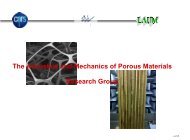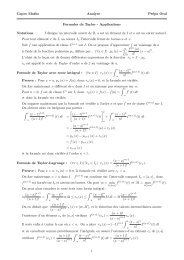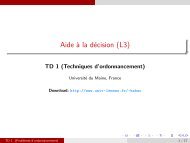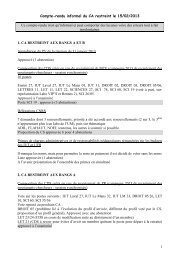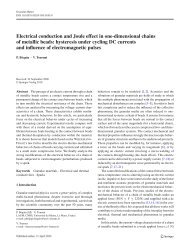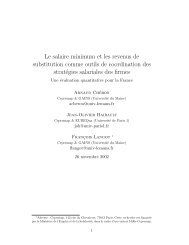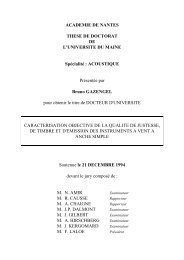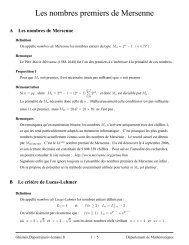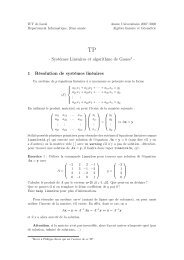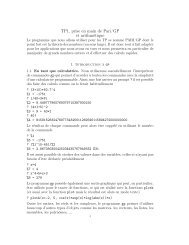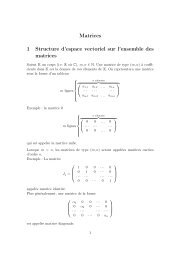Noise generated by cavitating single-hole and multi-hole orifices in ...
Noise generated by cavitating single-hole and multi-hole orifices in ...
Noise generated by cavitating single-hole and multi-hole orifices in ...
You also want an ePaper? Increase the reach of your titles
YUMPU automatically turns print PDFs into web optimized ePapers that Google loves.
ARTICLE IN PRESSP. Testud et al. / Journal of Fluids <strong>and</strong> Structures 23 (2007) 163–189 183Fig. 22. Choice of the variables d <strong>and</strong> U d for the scal<strong>in</strong>g of the noise spectra <strong>in</strong> the developed cavitation regime for the <strong>s<strong>in</strong>gle</strong>-<strong>hole</strong>orifice.that this scal<strong>in</strong>g should not hold <strong>in</strong> the case of the present study, as it also does not for sheet cavitation on airfoils(Keller, 1994).As we lack a precise model, the scal<strong>in</strong>g data are chosen for the sake of simplicity: the basic idea, as shown <strong>in</strong> Fig. 22,relies on the fact that, <strong>in</strong> the developed cavitation regime, the bubbles are created <strong>in</strong> the mix<strong>in</strong>g high-shear region of thejet.For the <strong>s<strong>in</strong>gle</strong>-<strong>hole</strong> orifice experiments, the velocity U d <strong>and</strong> the orifice diameter d are representative of the conditions<strong>in</strong> this region, hence those quantities are used <strong>in</strong> order to scale the noise spectra <strong>in</strong> this regime. Furthermore, the scal<strong>in</strong>gpressure is def<strong>in</strong>ed as the pressure drop DP across the orifice, which is a measure of the k<strong>in</strong>etic energy density <strong>in</strong> the jet.Hence for the <strong>s<strong>in</strong>gle</strong>-<strong>hole</strong> orifice <strong>in</strong> developed cavitation, fd=U d is the nondimensional frequency <strong>and</strong> p þ2 U d =ðDP 2 dÞ isthe nondimensional magnitude.For the <strong>multi</strong>-<strong>hole</strong> orifice experiments, we assume the noise issu<strong>in</strong>g from <strong>in</strong>coherent N <strong>hole</strong>s sources.Each source represents the radiation of one <strong>hole</strong>. It radiates on a characteristic surface of S=N <strong>hole</strong>s . The strength ofeach source is assumed to be <strong>in</strong>dependent of the environment of the source. This assumption is natural, as we havepreviously supposed (see previous section) that the noise <strong>generated</strong> <strong>by</strong> the <strong>s<strong>in</strong>gle</strong>-<strong>hole</strong> orifice does not depend on thediameter of the pipe. However, it should be po<strong>in</strong>ted out that this assumption is wrong when whistl<strong>in</strong>g occurs.In this model, the total acoustic power P measured downstream is a summation of the acoustic power P each sourceemitted <strong>by</strong> each source [the key element is that sources are supposed to be <strong>in</strong>coherent between each other, see Pierce(1981)]:P ¼ N <strong>hole</strong>s P each source . (15)The acoustic power of each source P each source is, <strong>by</strong> def<strong>in</strong>ition, the total acoustic <strong>in</strong>tensity flux I <strong>multi</strong>plied the surface ofthis source:P each source ¼ IS=N <strong>hole</strong>s . (16)Hence the total acoustic power isP ¼ SI. (17)The total acoustic power is consequently <strong>in</strong>dependent of the number of <strong>hole</strong>s. As previously, we ignore any downstreamreflections, so that I ¼ p þ2 =ðrcÞ.This argumentation based on energy considerations can also be conducted <strong>in</strong> terms of forces: if the source isrepresented as a force act<strong>in</strong>g on the orifice, tak<strong>in</strong>g the form Sp þ , the total force imposed on the <strong>multi</strong>-<strong>hole</strong> orifice is dueto the contribution of the forces imposed <strong>by</strong> N <strong>hole</strong>s equivalent <strong>s<strong>in</strong>gle</strong>-<strong>hole</strong> <strong>orifices</strong> with open surface S=N <strong>hole</strong>s . Thoseforces are supposed to be uncorrelated with each other. Thus, the total force squared equals N <strong>hole</strong>s times the forcesquared due to one <strong>hole</strong>. As the force squared of one <strong>hole</strong> is ðp þ S=N <strong>hole</strong>s Þ 2 , the total force squared is expressed as:N <strong>hole</strong>s ðp þ S=N <strong>hole</strong>s Þ 2 , or <strong>by</strong> simplify<strong>in</strong>g: ðp þ SÞ 2 =N <strong>hole</strong>s .The scal<strong>in</strong>g of the acoustic power is based on each source of surface S=N <strong>hole</strong>s . The scal<strong>in</strong>g velocity is the velocity atthe orifice, which is taken equal to the velocity of the <strong>s<strong>in</strong>gle</strong>-<strong>hole</strong> orifice U d , as the open surface of the two <strong>orifices</strong> arevery similar, <strong>and</strong> the scal<strong>in</strong>g length is the diameter of one <strong>hole</strong> d <strong>multi</strong> . In conclusion for the <strong>multi</strong>-<strong>hole</strong> orifice <strong>in</strong>developed cavitation: fd <strong>multi</strong> =U d is the nondimensional frequency, <strong>and</strong> p þ2 U d =ðDP 2 d <strong>multi</strong> Þ is the nondimensionalmagnitude.4.3.2. Nondimensional noise spectra <strong>generated</strong> downstreamThe dimensionless acoustical power spectra obta<strong>in</strong>ed downstream of the orifice for the developed cavitation regimeare given <strong>in</strong> Fig. 23 for the <strong>s<strong>in</strong>gle</strong>-<strong>hole</strong> orifice <strong>and</strong> <strong>in</strong> Fig. 24 for the <strong>multi</strong>-<strong>hole</strong> orifice. The follow<strong>in</strong>g observations areworth not<strong>in</strong>g.



